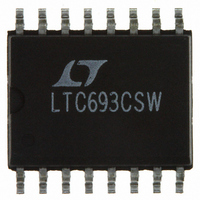LTC693CSW Linear Technology, LTC693CSW Datasheet - Page 10

LTC693CSW
Manufacturer Part Number
LTC693CSW
Description
IC MPU SUPERVISRY CIRCUIT 16SOIC
Manufacturer
Linear Technology
Type
Simple Reset/Power-On Resetr
Datasheet
1.LTC692CS8PBF.pdf
(20 pages)
Specifications of LTC693CSW
Number Of Voltages Monitored
1
Output
Open Drain or Open Collector
Reset
Active High/Active Low
Reset Timeout
140 ms Minimum
Voltage - Threshold
4.4V
Operating Temperature
0°C ~ 70°C
Mounting Type
Surface Mount
Package / Case
16-SOIC (0.300", 7.5mm Width)
Lead Free Status / RoHS Status
Contains lead / RoHS non-compliant
Other names
LTC693CS
Available stocks
Company
Part Number
Manufacturer
Quantity
Price
Part Number:
LTC693CSW
Manufacturer:
LINEAR/凌特
Quantity:
20 000
Part Number:
LTC693CSW#TRPBF
Manufacturer:
LTNEAR
Quantity:
20 000
LTC692/LTC693
The LTC692/LTC693 are protected for safe area operation
with a short-circuit limit. Output current is limited to ap-
proximately 200mA. If the device is overloaded for long
periods of time, thermal shutdown turns the power switch
off until the device cools down. The threshold temperature
for thermal shutdown is approximately 155°C with about
10°C of hysteresis which prevents the device from oscil-
lating in and out of shutdown.
The PNP switch used in competitive devices was not chosen
for the internal power switch because it injects unwanted
current into the substrate. This current is collected by the
V
current of the battery which can damage lithium batteries.
The LTC692/LTC693 use a charge-pumped NMOS power
switch to eliminate unwanted charging current while
achieving low dropout and low supply current. Since no
current goes to the substrate, the current collected by the
V
A 125Ω PMOS switch connects the V
battery backup mode. The switch is designed for very low
dropout voltage (input-to-output differential). This feature
is advantageous for low current applications such as bat-
tery backup in CMOS RAM and other low power CMOS
circuitry. The supply current in battery backup mode is
1μA maximum.
The operating voltage at the V
4.0V. High value capacitors, such as electrolytic or farad-
size double layer capacitors, can be used for short-term
APPLICATIONS INFORMATION
10
BATT
BATT
Figure 2. Using BATT ON to Drive External PNP Transistor
pin in competitive devices and adds to the charging
pin is strictly junction leakage.
5V
0.1μF
3V
ANY PNP POWER TRANSISTOR
3
1
V
V
BATT
CC
BATT ON
LTC693
GND
BATT
4
5
V
692_3 • F02
OUT
pin ranges from 2.0V to
2
BATT
input to V
0.1μF
OUT
in
memory backup instead of a battery. The charging resistor
for the rechargeable batteries should be connected to V
since this eliminates the discharge path that exists when
the resistor is connected to V
Replacing the Backup Battery
When changing the backup battery with system power on,
spurious resets can occur while the battery is removed
due to battery standby current. Although battery standby
current is only a tiny leakage current, it can still charge up
the stray capacitance on the V
is as follows: When V
the LTC692/LTC693 switch to battery backup. V
V
The leakage current then charges up the V
and the cycle repeats.
If spurious resets during battery replacement pose no
problems, then no action is required. Otherwise, a resistor
from V
the battery. For example, the battery standby current is
1μA maximum over temperature and the external resistor
required to hold V
With V
battery, this resistor will draw only 0.77μA from the bat-
tery, which is negligible in most cases.
BATT
R
≤
low and the devices go back to normal operation.
Figure 3. Charging External Battery Through V
BATT
CC
5V
V – 50mV
CC
0.1μF
= 4.25V, a 3.9M resistor will work. With a 3V
1 A
to GND will hold the pin low while changing
μ
3V
BATT
BATT
below V
I =
V
V
BATT
CC
V
LTC692
LTC693
OUT
GND
reaches within 50mV of V
R
BATT
– V
R
CC
V
692_3 • F03
CC
OUT
BATT
(Figure 3).
pin. The oscillation cycle
is:
BATT
0.1μF
OUT
pin again
OUT
pulls
0692fb
OUT
CC
,














